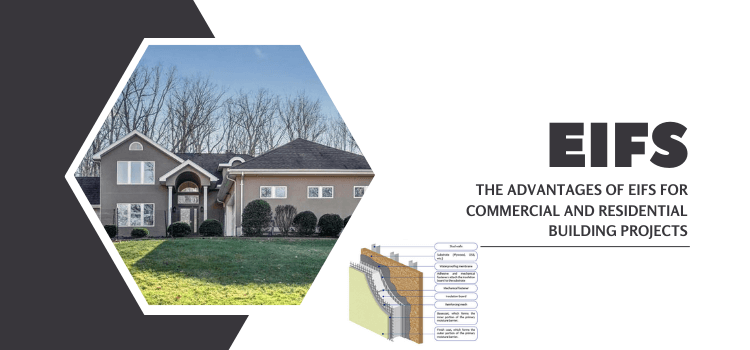
Exterior Insulation Finishing Systems (EIFS) have become increasingly popular in both commercial and residential building projects. These systems are designed to provide insulation, waterproofing, and aesthetic appeal to buildings. In this article, we will explore the advantages of EIFS and why it’s an excellent choice for any building project. We’ll also discuss the importance of using an EIFS estimator to ensure the proper installation and maintenance of the system.
What are EIFS?
EIFS is a cladding system that consists of an insulation board attached to the exterior walls of a building, followed by a layer of base coat and reinforcing mesh. Finally, a finish coat is applied to the system, providing a decorative and protective finish. EIFS is typically used in areas with moderate climates and provides a high level of insulation, making it an energy-efficient choice for both commercial and residential buildings.
Advantages of EIFS
Energy Efficiency
One of the significant advantages of EIFS is its energy efficiency. The insulation board used in EIFS provides excellent thermal insulation, which helps to regulate the temperature inside the building, reducing the amount of energy required to heat or cool it. The energy savings can translate into lower heating and cooling costs, which can have a significant impact on the building’s operating expenses.
Durability
EIFS is a highly durable cladding system that can withstand a variety of weather conditions. The system is designed to be resistant to cracking, fading, and chalking, making it a low maintenance choice for building owners. Additionally, the system can be customized to match the style and design of the building, providing a long-lasting and aesthetically pleasing finish.
Waterproofing
Another significant advantage of EIFS is its waterproofing capabilities. The system is designed to prevent water infiltration, which can lead to structural damage and mould growth. The base coat and reinforcing mesh used in the system provide a waterproof barrier that helps to protect the building from moisture.
Design Flexibility
EIFS provides design flexibility, allowing architects and designers to create unique and eye-catching designs. The finish coat can be customized to match the building’s style and design, providing a wide range of colour and texture options. Additionally, the system can be used to create a variety of architectural details, such as columns, arches, and cornices.
Cost-Effective
EIFS is a cost-effective choice for building owners. The system’s energy efficiency can translate into lower heating and cooling costs, reducing the building’s operating expenses. Additionally, the system’s durability and low maintenance requirements can reduce the need for costly repairs and replacements.
Using an EIFS Estimator
To ensure the proper installation and maintenance of an EIFS system, it’s essential to use an EIFS estimator. An estimator can help to determine the materials and labor required for the project, ensuring that the system is installed correctly and meets the building’s requirements. Additionally, an estimator can help to identify any potential issues with the system and provide recommendations for maintenance and repairs.
When choosing an EIFS estimator, it’s essential to select a qualified professional with experience in the industry. The estimator should have a thorough understanding of EIFS systems and be familiar with local building codes and regulations. Additionally, the estimator should be able to provide references and examples of previous projects.
EIFS and Sustainability
EIFS can also be an eco-friendly choice for building owners. The insulation board used in the system is typically made from recycled materials, reducing waste and the need for new resources. Additionally, the energy efficiency provided by EIFS can reduce the building’s carbon footprint and help to reduce greenhouse gas emissions. By using EIFS, building owners can not only save money but also contribute to a more sustainable future.
EIFS vs. Traditional Stucco
Many building owners may wonder how EIFS compares to traditional stucco. While both systems provide a decorative and protective finish, there are some significant differences between the two. Traditional stucco is a cement-based system that is applied directly to the exterior walls of a building. It provides some insulation but not as much as EIFS. Additionally, traditional stucco is more prone to cracking and fading, requiring more maintenance over time. EIFS, on the other hand, provides a higher level of insulation, durability, and design flexibility. While both systems have their advantages and disadvantages, many building owners choose EIFS for its energy efficiency, low maintenance, and aesthetic appeal.
EIFS Installation and Maintenance
Proper installation and maintenance are crucial for the long-term success of an EIFS system. During installation, it’s important to follow the manufacturer’s guidelines and local building codes and regulations. Additionally, it’s essential to use the proper materials and tools to ensure a successful outcome. Once installed, regular maintenance is necessary to ensure the system’s durability and performance. This may include regular inspections, cleaning, and repairs as needed. Working with an experienced EIFS contractor and using an EIFS estimator can help to ensure proper installation and maintenance of the system.
Conclusion
EIFS is an excellent choice for both commercial and residential building projects. The system provides energy efficiency, durability, waterproofing capabilities, design flexibility, and cost-effectiveness. Additionally, using an EIFS estimator can help to ensure the proper installation and maintenance of the system, providing long-lasting benefits for building owners. If you’re considering an EIFS system for your building project, be sure to work with Estimating Edge to ensure a successful outcome.






Leave a Reply